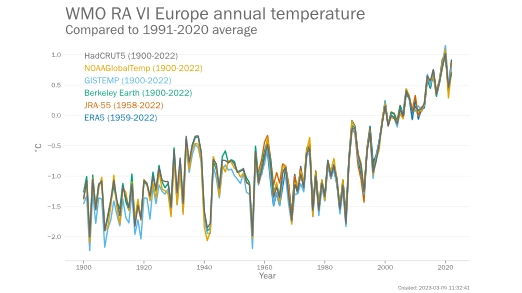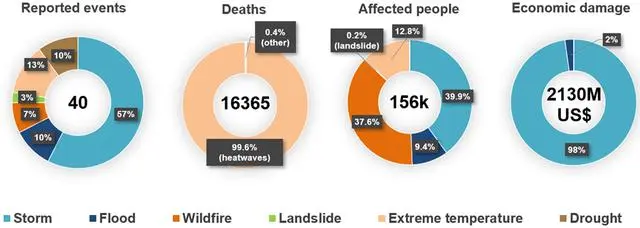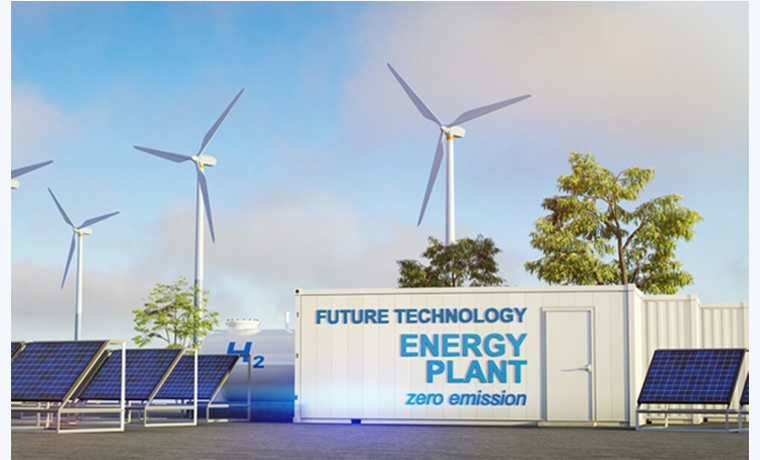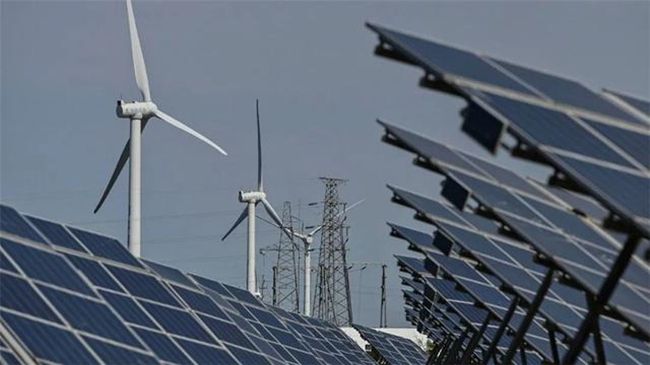Climate change is causing significant economic and environmental losses in Europe, the continent experiencing the fastest global warming.
According to the "2022 European Climate Condition Report" jointly compiled by the World Meteorological Organization (WMO) and the Copernicus Climate Change Service of the European Union, Europe experienced extreme heat, droughts, and wildfires in 2022. Sea surface temperatures reached new highs, accompanied by marine heatwaves, and unprecedented glacier melting.
The report reveals that since the 1980s, Europe has warmed twice as much as the global average, profoundly impacting the region's socioeconomic structure and ecosystems. In 2022, Europe was about 2.3℃ warmer than the pre-industrial average (1850-1900), which is commonly used as a baseline for the Paris Agreement.
However, the report also shows that in 2022, renewable energy generation in Europe surpassed fossil fuels for the first time, with wind and solar power accounting for 22.3% of EU electricity, exceeding fossil fuels' share (20%).

Increasing Extreme Weather Leads to Heat Stress
The report highlights energy-related issues and emphasizes the growing impact of more frequent and intense extreme weather events, including heatwaves, heavy rainfall, and droughts, on Europe's energy supply, demand, and infrastructure.
"The record-breaking heat stress experienced by Europeans in 2022 was one of the main driving factors behind weather-related excess mortality in Europe. Unfortunately, this cannot be seen as a one-time event or a climatic oddity. Dr. Carlo Buontempo, Director of the Copernicus Climate Change Service, stated, "Our current understanding of the climate system and its evolution tells us that these events are part of a pattern that will make extreme heat stress events more frequent and intense across the entire region."
According to the Emergency Events Database (EM-DAT), meteorological, hydrological, and climate-related hazards in Europe led to 16,365 deaths in 2022 and directly affected 156,000 people.
Approximately 67% of the events were associated with floods and storms, accounting for a significant portion of the total economic losses, estimated at around $2 billion. In terms of mortality, heatwaves were the most severe, resulting in over 16,000 deaths.

"Many countries in Western and Southwest Europe experienced their warmest year on record in 2022." Secretary-General of the WMO, Petteri Taalas, stated, "The summer was the hottest ever recorded: high temperatures intensified severe and widespread drought conditions, fueled intense wildfires, resulting in the second-largest burned area ever, and caused tens of thousands of excess deaths linked to heat."
According to another study by the Copernicus Climate Change Service of the European Commission, Europeans, especially those in southern continental Europe, faced increased heat stress during the summer due to longer periods of extreme weather events caused by climate change.
The research found that "Southern Europe experienced a record number of 'very strong heat stress' days," indicating temperatures ranging from 38 to 46 degrees Celsius.
In fact, the number of days with "strong" heat stress (32 to 38 degrees Celsius) or "very strong" heat stress is increasing throughout the entire European continent, with an increase in the number of "extreme heat stress" days above 46 degrees Celsius in southern Europe. The resulting heat stress leads to a range of health problems, including rashes, dehydration, and heatstroke.
Europe experienced its warmest summer on record in 2022. Several countries, including Belgium, France, Germany, Ireland, Italy, Luxembourg, Portugal, Spain, Switzerland, and the United Kingdom, reported their warmest year.
Europe experienced its warmest summer on record in 2022. Several countries, including Belgium, France, Germany, Ireland, Italy, Luxembourg, Portugal, Spain, Switzerland, and the United Kingdom, reported their warmest year ever. The heatwave led to severe consequences, such as crop failures, water shortages, and increased energy demand for cooling.
Renewable Energy Surpasses Fossil Fuels
Despite the challenges posed by extreme weather events, there is a positive development in the energy sector. The report highlights that renewable energy generation in Europe surpassed fossil fuels for the first time in 2022. Wind and solar power accounted for 22.3% of electricity generation in the European Union, surpassing fossil fuels' share of 20%.
This milestone reflects the growing investment in renewable energy infrastructure, as well as the declining costs of renewable technologies. European countries have been actively transitioning to cleaner energy sources to reduce greenhouse gas emissions and mitigate climate change. The increased adoption of wind and solar power has played a crucial role in achieving this shift.
The report indicates that the record-breaking heat and associated extreme weather events have further highlighted the urgency of transitioning to a low-carbon economy. Renewable energy sources provide a more sustainable and resilient alternative to fossil fuels, which are major contributors to climate change.
The European Union has set ambitious renewable energy targets as part of its climate action goals. The EU aims to achieve at least a 32% share of renewable energy in its final energy consumption by 2030. The surpassing of fossil fuels by renewables in 2022 demonstrates progress towards these targets.

Challenges and Opportunities
While the growth of renewable energy is encouraging, there are still challenges to overcome. The intermittency of wind and solar power poses a reliability issue, as energy generation depends on weather conditions. Therefore, effective energy storage and grid integration solutions are essential to ensure a stable and resilient energy system.
Investments in research and development are crucial to advance energy storage technologies, such as battery storage and hydrogen, which can help address the intermittency challenge and support the integration of renewable energy into the grid.
Furthermore, enhancing cross-border cooperation and transmission infrastructure can enable the efficient sharing and distribution of renewable energy across Europe. Collaborative efforts can also lead to a more interconnected and robust energy network, facilitating the integration of renewable energy sources.
The transition to renewable energy not only brings environmental benefits but also presents economic opportunities. It stimulates job creation in the renewable energy sector, fosters innovation, and reduces dependence on fossil fuel imports. By embracing the clean energy transition, Europe can position itself as a global leader in sustainable development and contribute to the fight against climate change.
Europe's experience of extreme heat, droughts, and wildfires in 2022 highlights the urgency of addressing climate change and transitioning to renewable energy sources. The surpassing of fossil fuels by renewables in electricity generation is a significant milestone and reflects the progress made in decarbonizing the energy sector.
To accelerate the clean energy transition, continued investment in renewable energy infrastructure, energy storage technologies, and grid integration is necessary. Additionally, cross-border collaboration and supportive policies are vital for achieving Europe's renewable energy targets and building a sustainable and resilient energy system.
By prioritizing renewable energy and taking bold actions, Europe can pave the way for a greener future and inspire other regions to follow suit in mitigating the impacts of climate change.
OWELL Wind Energy and Energy Transition
One of the key contributors to the renewable energy sector is OWELL vertical-axis wind turbines. These innovative wind turbines have gained attention for their unique design and potential benefits in the energy transition.
OWELL vertical-axis wind turbines offer several advantages over traditional horizontal-axis wind turbines. Their design allows for omnidirectional wind capture, meaning they can generate electricity from wind coming from any direction, eliminating the need for constant adjustments to align with wind direction. At the current stage, 5KW vertical wind turbines are popular selling in European markets.
Furthermore, these turbines are generally quieter, have a lower risk of bird strikes, and require less space compared to horizontal-axis wind turbines. This makes them suitable for installation in urban and densely populated areas, where traditional wind turbines may face more significant challenges.
OWELL wind turbines can contribute to the diversification of renewable energy sources, especially in locations where space or wind conditions limit the installation of traditional wind turbines. By harnessing wind energy more efficiently and overcoming certain limitations, OWELL turbines can enhance the overall capacity and resilience of the renewable energy infrastructure.
Standby Diesel Generator Sets and Renewable Energy Stability
While renewable energy sources like wind and solar power offer tremendous potential, their intermittent nature poses challenges to the stability and predictability of the energy grid. Standby diesel generator sets can provide a solution to address these concerns.
Diesel generator sets serve as backup power sources that can be deployed when renewable energy generation fluctuates or falls short of demand. These generators can quickly ramp up and provide a stable power supply to support the grid during periods of low renewable energy production or unexpected spikes in demand.
By integrating standby diesel generator sets into the energy system, the intermittency and unpredictability of renewable energy can be mitigated. These generators act as a reliable backup to ensure a continuous power supply, thus enhancing the grid's stability and reliability.
However, it's important to note that while diesel generator sets can offer short-term stability, they are not a long-term solution for achieving a sustainable and decarbonized energy system. The primary focus should still be on increasing the share of renewable energy sources and developing energy storage technologies to address the intermittency issue.

Striking a Balance for a Sustainable Energy Future
In the pursuit of a sustainable energy future, striking a balance is crucial. While OWELL vertical-axis wind turbines and standby diesel generator sets offer certain benefits, their roles should be considered within the broader context of renewable energy transition.
The priority should be given to accelerating the deployment of renewable energy sources, such as wind and solar power, and investing in energy storage technologies. This will help reduce reliance on fossil fuels, mitigate greenhouse gas emissions, and build a resilient and sustainable energy system.
While standby diesel generator sets can serve as a short-term solution for stabilizing the energy grid, efforts should focus on minimizing their use and transitioning towards cleaner alternatives, such as battery storage systems or hydrogen-based technologies. This will ensure a more sustainable and environmentally friendly energy transition.
In conclusion, OWELL wind energy can contribute to the diversification of renewable energy sources, while standby diesel generator sets can address the issue of renewable energy instability and unpredictability in the short term. However, long-term solutions should prioritize the expansion of renewable energy capacity and the development of energy storage technologies to achieve a sustainable energy future.